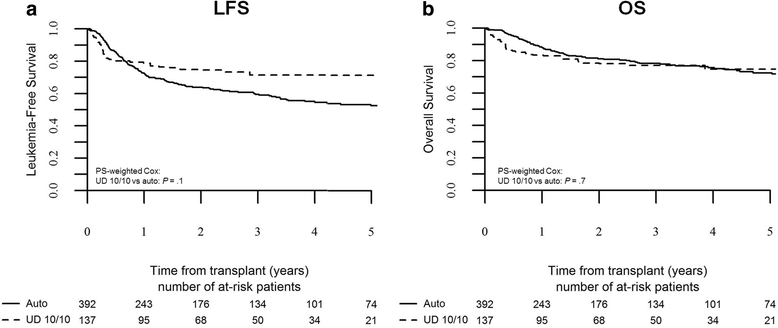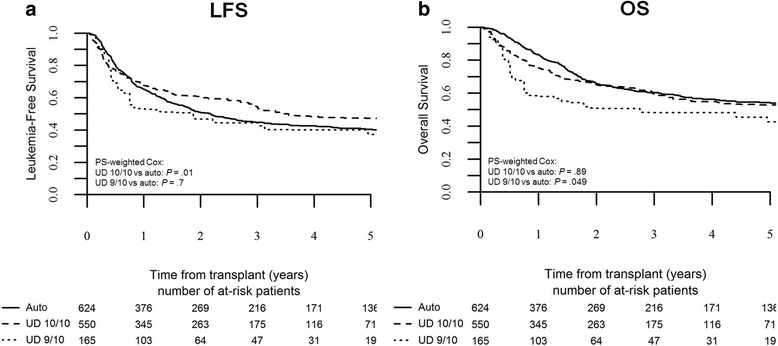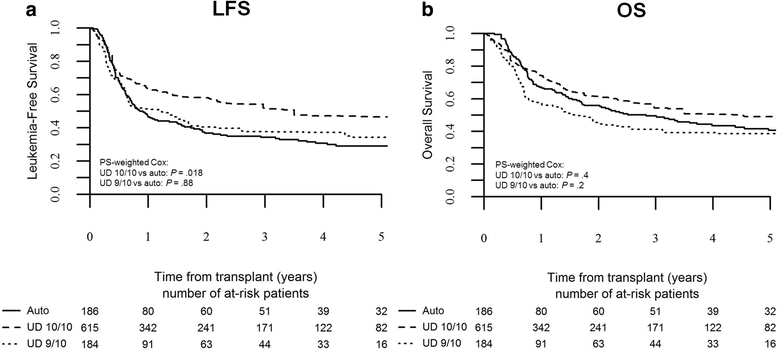Matched and mismatched unrelated donor compared to autologous stem cell transplantation for acute myeloid leukemia in first complete remission: a retrospective, propensity score-weighted analysis from the ALWP of the EBMT
- PMID: 27589849
- PMCID: PMC5009662
- DOI: 10.1186/s13045-016-0314-x
Matched and mismatched unrelated donor compared to autologous stem cell transplantation for acute myeloid leukemia in first complete remission: a retrospective, propensity score-weighted analysis from the ALWP of the EBMT
Abstract
Background: Optimal post-remission strategy for patients with acute myeloid leukemia (AML) is matter of intense debate. Recent reports have shown stronger anti-leukemic activity but similar survival for allogeneic stem cell transplantation (allo-HSCT) from matched sibling donor compared to autologous transplantation (auto-HSCT); however, there is scarcity of literature confronting auto-HSCT with allo-HSCT from unrelated donor (UD-HSCT), especially mismatched UD-HSCT.
Methods: We retrospectively compared outcome of allogeneic transplantation from matched (10/10 UD-HSCT) or mismatched at a single HLA-locus unrelated donor (9/10 UD-HSCT) to autologous transplantation in patients with AML in first complete remission (CR1). A total of 2879 patients were included; 1202 patients received auto-HSCT, 1302 10/10 UD-HSCT, and 375 9/10 UD-HSCT. A propensity score-weighted analysis was conducted to control for disease risk imbalances between the groups.
Results: Matched 10/10 UD-HSCT was associated with the best leukemia-free survival (10/10 UD-HSCT vs auto-HSCT: HR 0.7, p = 0.0016). Leukemia-free survival was not statistically different between auto-HSCT and 9/10 UD-HSCT (9/10 UD-HSCT vs auto-HSCT: HR 0.8, p = 0.2). Overall survival was similar across the groups (10/10 UD-HSCT vs auto-HSCT: HR 0.98, p = 0.84; 9/10 UD-HSCT vs auto-HSCT: HR 1.1, p = 0.49). Notably, in intermediate-risk patients, OS was significantly worse for 9/10 UD-HSCT (9/10 UD-HSCT vs auto-HSCT: HR 1.6, p = 0.049), while it did not differ between auto-HSCT and 10/10 UD-HSCT (HR 0.95, p = 0.88). In favorable risk patients, auto-HSCT resulted in 3-year LFS and OS rates of 59 and 78 %, respectively.
Conclusions: Our findings suggest that in AML patients in CR1 lacking an HLA-matched sibling donor, 10/10 UD-HSCT significantly improves LFS, but this advantage does not translate in better OS compared to auto-HSCT. In intermediate-risk patients lacking a fully HLA-matched donor, auto-HSCT should be considered as a valid option, as better survival appears to be provided by auto-HSCT compared to mismatched UD-HSCT. Finally, auto-HSCT provided an encouraging outcome in patients with favorable risk AML.
Keywords: Acute myeloid leukemia (AML); Allogeneic transplantation; Autologous transplantation; Matched (10/10) and mismatched (9/10) unrelated donor transplantation; Post-remission therapy.
Figures




Similar articles
-
Unrelated donor versus matched sibling donor in adults with acute myeloid leukemia in first relapse: an ALWP-EBMT study.J Hematol Oncol. 2016 Sep 17;9(1):89. doi: 10.1186/s13045-016-0321-y. J Hematol Oncol. 2016. PMID: 27639553 Free PMC article.
-
Comparable outcomes among unmanipulated haploidentical, matched unrelated, and matched sibling donors in BU-based myeloablative hematopoietic stem cell transplantation for intermediate and adverse risk acute myeloid leukemia in complete remission: a single-center study.Ann Hematol. 2021 Jun;100(6):1579-1591. doi: 10.1007/s00277-020-04355-1. Epub 2020 Nov 24. Ann Hematol. 2021. PMID: 33236196
-
Comparable outcomes of haploidentical, 10/10 and 9/10 unrelated donor transplantation in adverse karyotype AML in first complete remission.Am J Hematol. 2018 Oct;93(10):1236-1244. doi: 10.1002/ajh.25231. Epub 2018 Sep 3. Am J Hematol. 2018. PMID: 30058714
-
Effects of post-remission chemotherapy before allo-HSCT for acute myeloid leukemia during first complete remission: a meta-analysis.Ann Hematol. 2018 Sep;97(9):1519-1526. doi: 10.1007/s00277-018-3414-6. Epub 2018 Jun 26. Ann Hematol. 2018. PMID: 29946906
-
Effects of donor-engrafted clonal hematopoiesis in allogeneic and autologous stem cell transplantation: a systematic review and meta-analysis.Bone Marrow Transplant. 2024 Nov;59(11):1585-1593. doi: 10.1038/s41409-024-02403-2. Epub 2024 Aug 25. Bone Marrow Transplant. 2024. PMID: 39183321 Free PMC article.
Cited by
-
Hematopoietic stem cell transplantation for acute myeloid leukemia.Int J Hematol. 2018 May;107(5):513-518. doi: 10.1007/s12185-018-2412-8. Epub 2018 Jan 27. Int J Hematol. 2018. PMID: 29374826 Review.
-
Allogeneic stem cell transplantation in adult patients with acute myeloid leukaemia and 17p abnormalities in first complete remission: a study from the Acute Leukemia Working Party (ALWP) of the European Society for Blood and Marrow Transplantation (EBMT).J Hematol Oncol. 2017 Jan 18;10(1):20. doi: 10.1186/s13045-017-0393-3. J Hematol Oncol. 2017. PMID: 28100265 Free PMC article.
-
Comparison of post-remission strategies in acute myeloid leukemia: Autologous hematopoietic stem cell transplantation versus consolidation chemotherapy.Hematol Rep. 2020 Dec 2;12(3):8380. doi: 10.4081/hr.2020.8380. eCollection 2020 Dec 2. Hematol Rep. 2020. PMID: 33324478 Free PMC article.
-
PTCy versus ATG as graft-versus-host disease prophylaxis in mismatched unrelated stem cell transplantation.Blood Cancer J. 2024 Mar 15;14(1):45. doi: 10.1038/s41408-024-01032-8. Blood Cancer J. 2024. PMID: 38485723 Free PMC article.
-
Autologous Stem Cell Transplantation Is a Viable Postremission Therapy for Intermediate-Risk Acute Myeloid Leukemia in First Complete Remission in the Absence of a Matched Identical Sibling: A Meta-Analysis.Acta Haematol. 2019;141(3):164-175. doi: 10.1159/000495206. Epub 2019 Feb 26. Acta Haematol. 2019. PMID: 30808826 Free PMC article.
References
-
- Schlenk RF, Döhner K, Mack S, Stoppel M, Király F, Götze K, et al. Prospective evaluation of allogeneic hematopoietic stem-cell transplantation from matched related and matched unrelated donors in younger adults with high-risk acute myeloid leukemia: German-Austrian trial AMLHD98A. J Clin Oncol. 2010;28(30):4642–8. doi: 10.1200/JCO.2010.28.6856. - DOI - PubMed
-
- Verneris MR, Lee SJ, Ahn KW, Wang HL, Battiwalla M, Inamoto Y, et al. HLA mismatch is associated with worse outcomes after unrelated donor reduced-intensity conditioning hematopoietic cell transplantation: an analysis from the center for international blood and marrow transplant research. Biol Blood Marrow Transplant. 2015;21(10):1783–9. doi: 10.1016/j.bbmt.2015.05.028. - DOI - PMC - PubMed
-
- Savani BN, Labopin M, Kröger N, Finke J, Ehninger G, Niederwieser D, et al. Expanding transplant options to patients over 50 years—improved outcome after reduced intensity conditioning mismatched-unrelated donor transplantation for patients with acute myeloid leukemia: a report from the Acute Leukemia Working Party of the EBMT. Haematologica. 2016;101(6):773–80. doi: 10.3324/haematol.2015.138180. - DOI - PMC - PubMed
-
- Kanakry CG, O’Donnell PV, Furlong T, de Lima MJ, Wei W, Medeot M, et al. Multi-institutional study of post-transplantation cyclophosphamide as single-agent graft-versus-host disease prophylaxis after allogeneic bone marrow transplantation using myeloablative busulfan and fludarabine conditioning. J Clin Oncol. 2014;32(31):3497–505. doi: 10.1200/JCO.2013.54.0625. - DOI - PMC - PubMed
Publication types
MeSH terms
LinkOut - more resources
Full Text Sources
Other Literature Sources
Medical
Research Materials

